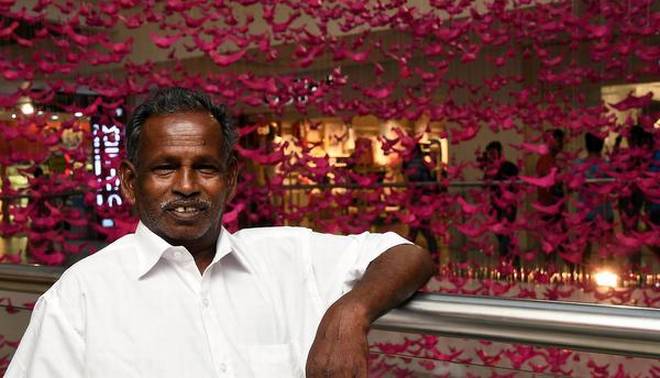Pollachi-based T Krishnasamy, an artisan who works with palm leaves, has made 6,000 parrots for an installation in the city
T Krishnasamy’s palms are criss-crossed with cuts. Thirty years of handling palm leaves is bound to leave a mark and the 63-year-old artisan knows this. “It happens,” he shrugs when asked about it. Krishnasamy works with olai or palm leaves to create works of art — from sharp-nosed parrots, to diamond-shaped fish, and intricate deer — he bends and folds the leaves, cuts, and tucks them to create the shapes. Krishnasamy and his small team have made around 6,000 parrots that are part of Phoenix MarketCity’s spring-summer décor. A breathtaking sight, the décor is part of the mall’s initiative to provide a platform for traditional artisans.
Seated on the floor at the mall’s ground floor, over the last weekend, Krishnasamy gave a demonstration of palm leaf figurines. Visitors stop by and request him for a parrot in pink or a fish in blue, and he obliges, giving it away for free. People pose non-stop near the installation bearing hundreds of parrots. But the dhoti-clad man sits absorbed in work, unaffected by all the attention his work is getting.
Krishnasamy is from Kulathur village near Pollachi. He climbed palmyra trees for a living. “I brought down nungu (palm fruit) and thelivu or pathaneer (drink made of sap from the tree),” he says. One day, he happened to see a group of men working with palm leaves. “They were creating decoration items for the palace of the zamindar of Pollachi,” he recalls. He was in his twenties then and was fascinated that the very leaves he merely brushed against every day were transformed into works of art. “I just stood and observed them and learned the craft,” he adds.
Today, Krishnasamy is well-known in and around his home town for his art. His palm leaf artefacts decorate wedding stages and halls at functions. He’s created thousands of them over the course of the last few years. “I can make one in under three minutes,” he says. Krishnasamy processes the palm leaves in his kitchen. “I put the leaves to dry on the first day; trim, clean, and boil them with colour the next. They are ready to be shaped after I dry them for two more days,” he adds.
Back in his village, he usually keeps a stock of a few hundred parrots. But that’s nothing when compared to the volume that he makes on order. “Some five years ago, I made 20,000 parrots for an event organised when the Governor visited Pollachi,” he says. He has a small team of college girls that works for him after classes. But other than that, he’s on his own. If you visit him at Kulathur, you would see him engrossed in work, surrounded by palm leaves dyed in pink, blue, and green. “During the wedding season, I work from 4 am to 12 am,” he says.
His parrots have flown to various cities, but this is his first time in Chennai. “I like this city,” he smiles. “But I like my village better. It’s breezy and the weather is much cooler.” As we leave, he requests for a copy of the paper with his interview to be couriered to his village. He gives us an incomplete address though. “Just address it to kili kaarar (the parrot man),” he says. “It’ll reach me.”
source: http://www.thehindu.com / The Hindu / Home> Society / by Akila Kannadasan / April 24th, 2018
